(This Challenge has been completed.)
Game Design Showdown
February 2009 Challenge - "Back in time: roll-and-move"
Design a board or card game with an interesting variation of rolling dice and moving pawns/tokens as the (or one of the) core mechanic(s).
Theme:
Going back to the past. This can be literally taken as time-travel, or more loosely, e.g.: archaeology, ancient setting, Memento-style flashbacks or Benjamin-Buttonly getting younger as time passes. Designers are encouraged to be creative in this respect.
Additional Design Requirement:
The core mechanic, or one of the core mechanics of the game must be an interesting twist of the old and usually despised roll and move mechanic used in games like Shutters and Ladders or Parchis. One or more dice should be rolled, and the result should affect in some (not necessarily direct) way how, where to, which, by what player or when pawns are moved on the board. Again, be creative.
Formatting Request:
Please use the GDS formatting template as a reference to format your entries before submitting. No entry will be dismissed for lack of proper formatting, but entrants using the template will be thanked from the bottom of my heart.
- Start Date: Thursday, 12-February-2009
- End Date: Thursday, 19-February-2009, Noon US Eastern time (approximately)
- Voting: Thusrday, 19-February-2009 through Thursday, 26-February-2009.
Please use this thread for comments and questions. For more details on how these Game Design Showdown Challenges work, visit the GDS Wiki Page.
Please note, you must PM or e-mail me, seo, your GDS entry for this month not Brykovian. If you want to use e-mail, please PM me for my e-mail address.



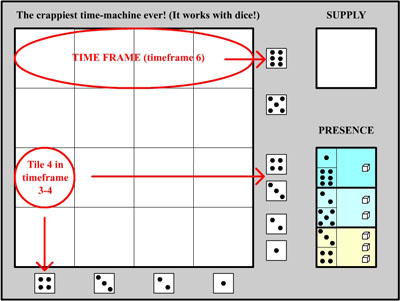
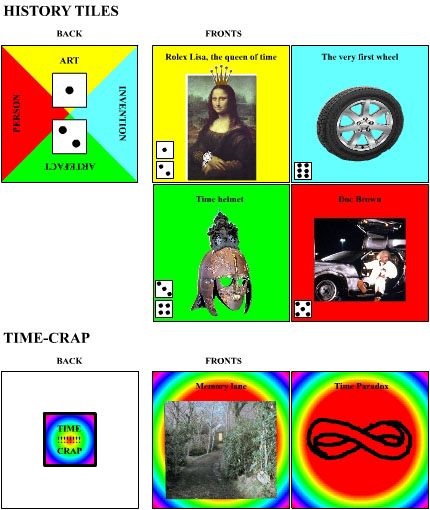
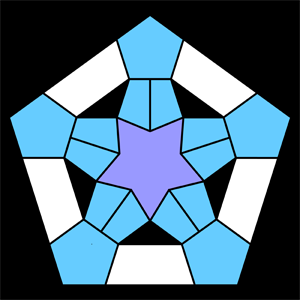
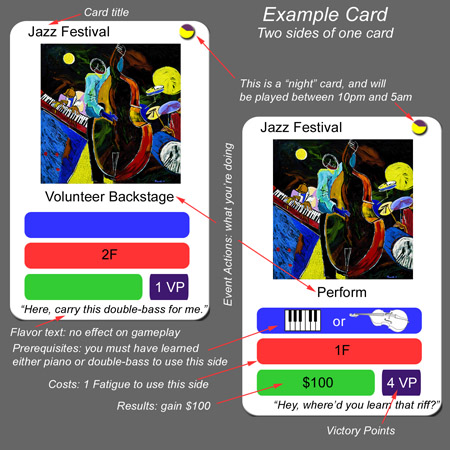
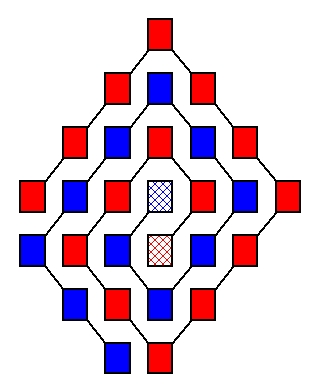

by Jonathan Leistiko (InvisibleJon)
A time agent has gone rogue. Neutralize the rogue agent before they cause irreparable damage. Permanent removal is mandatory. They may claim to be innocent. Do not believe their lies. Good luck.
Object:
Travel through time and space and manipulate the timestream to erase all trace of your opponent
You Need:
Setup:
Claim a set of pawns, an Energy token, and a six-sided die. Put the board in between the players. Each numbered row represents a specific location. All yellow spaces are locations in the present. The blue spaces are the same locations in the future. The red spaces are the same locations in the past. Place your pawn in a Present space. If a pawn is already on the board, do not place your pawn four spaces away from your opponent’s pawn.
Set the tokens nearby.
Play:
Play takes place in phases. Everyone gets to act in each phase before the next phase starts. The phases are: Energize, Initiative, Act, The March, and The Future.
Energize:
Gain one energy for each pawn you have on the board.
Initiative:
Hide 0 or more energy in your hand. Hold out that hand. When everyone has hands out, reveal what’s in your hand. If you reveal the most energy, you choose who acts first in the Act phase. If you’re tied, roll to determine a winner. All revealed energy is spent.
Act:
Starting with the first player, take turns activating pawns. After you activate a pawn, your opponent gets to do the same, then control returns to you, and so on. Each pawn you control can act once.When a pawn finishes acting, set it on its side to indicate you’ve used it. When a pawn acts, it can Move, Exert, and Shift. It can do these things in any order.
Moving (through space):
Roll your six-sided die. Move your pawn to a space exactly that many steps away in the same temporal zone. Example: Present location 1 wraps around to Present location 8 and vice versa. If you are in Present location 6 and roll a 3, you must move to Present location 1 or Present location 3. - When a pawn lands in a space with a Hazard, or vice versa, put the Hazard under that pawn; it is a Wound now. If your pawn has three or more Wounds, remove it and its Wounds from the board. - When a pawn lands in a space with a Haven, or vice versa, remove a Wound from that pawn (if it has one) and remove the Haven. Hazards trigger before Havens. - When a pawn lands in a space occupied by another pawn, remove both pawns, put a Hazard in that space, and in every past and future version of that space. These Hazards are “landing in” their respective spaces.
Exerting:
When a pawn exerts, it may: Gather Power or Alter Fate. - Gather Power: Gain one energy. - Alter Fate: Spend one energy. Place or remove a Haven or Hazard token in any past or future version of the pawn’s current location.
Shifting (in time):
Spend up to four energy. Move the pawn one step, into an adjacent future or past version of the pawn’s current space, for every energy you spent.
The March:
All pieces in the Distant Past move into the Permanent Past and are removed from play. All pieces in the Immediate Past move into the Distant Past. All pieces in the Present place copies of themselves in the Immediate Past. All pieces in the Near Future move into the Present. All pieces in the Far Future move into the Near Future.
The Future:
Roll the ten- and 12-sided dice. Place a Hazard token in the Far Future spaces in the location numbers you rolled. Ignore results that are not on the board. Roll the dice again, but place Haven tokens this time. Example: I roll a 7 and an 11. A Hazard appears in the Far Future of location 7. I roll again and get a 3 and 7. Havens appear in the Far Future in locations 3 and 7. Location 7 has a Hazard and a Haven on it. If every player has at least one pawn on the board, play continues with a new Energize phase. If only you have a pawn in play, you win. If no pawns are on the board, your corrupt boss at the Time Agency wins (& everyone loses).